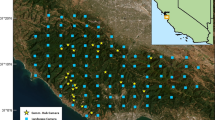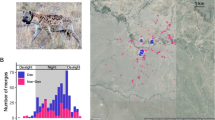Abstract
Maternal-offspring interactions are important in a variety of animals. Understanding the evolution of these interactions requires that we also study the broader social context in which they occur. To date, behavioral studies on burrower bugs, Sehirus cinctus, have focused exclusively on interactions between mothers and offspring. Here we ask whether these interactions occur in a social context that extends beyond the family unit of a mother and her own genetic offspring. Such social structure can arise from behaviors that occur before eggs are laid, or from actions of individuals that occur post-hatching. We present field data showing that lay sites of mothers are spatially aggregated on a scale that would lead to behavioral interactions among families. Microsatellite markers suggest neighboring mothers are unrelated. Laboratory experiments do not support the hypothesis that spatial aggregation results from a direct attraction of females to one another. Other laboratory studies reported here indicate that, after hatching, unrelated clutches sometimes join together to form multifamily groups. Experiments reveal that mothers are not necessary for these joining events to occur. In sum, these data suggest that both mothers and offspring play active, but different, roles in generating the social environment in which offspring rearing occurs.




Similar content being viewed by others
References
Agrawal AF, Brodie ED III, Brown J (2001) Parent-offspring coadaptation and the dual genetic control of maternal care. Science 292:1710–1712
Arnold SJ (1994) Multivariate inheritance and evolution: a review of concepts. In: Boake CRB (ed) Quantitative genetic studies of behavioral evolution. University of Chicago Press, Chicago, pp 17–48
Austad SN, Rabenold KN (1985) Reproductive enhancement by helpers and an experimental inquiry into its mechanism in the bicolored wren Campylorhynchus griseus. Behav Ecol Sociobiol 17:19–28
Avilés L (1997) Causes and consequences of cooperation and permanent-sociality in spiders. In: Choe JC, Crespi BJ (eds) The evolution of social behavior in insects and arachnids. Cambridge University Press, Cambridge, pp 476–498
Brown JL (1987) Helping and communal breeding in birds. Princeton University Press, Princeton
Brown JM, Agrawal AF, Brodie ED III (2003) An analysis of single clutch paternity in the burrower bug Sehirus cinctus using microsatellites. J Insect Behav 16:731–745
Clutton-Brock TH (1991) The evolution of parental care. Princeton University Press, Princeton
Clutton-Brock TH (2002) Breeding together: kin selection and mutualism in cooperative vertebrates. Science 296:69–72
Crozier RH, Pamilo P (1996) Evolution of social insect colonies: sex allocation and kin selection. Oxford University Press, New York
Diggle PJ (1983) Statistical analysis of spatial point patterns. Academic, New York
Eadie JM, Kehoe FP, Nudds TD (1988) Pre-hatch and post-hatch brood amalgamation in North American Anatidae: a review of hypotheses. Can J Zool 66:1709–1721
Edgerly JS (1997) Life beneath silk walls: a review of the primatively social Embiidina. In: Choe JC, Crespi BJ (eds) The evolution of social behavior in insects and arachnids. Cambridge University Press, Cambridge, pp 14–25
Eickwort GC (1981) Presocial insects. In: Hermann HR (ed) Social insects, vol 2. Academic, New York, pp 199–280
Emlen ST (1990) White-fronted bee-eaters: helping in a colonially nesting species. In: Stacey PB, Koenig WD (eds) Cooperative breeding in birds. Cambridge University Press, New York, pp 487–526
Evans RM (1984) Some causal and functional correlates of creching in young white pelicans. Can J Zool 62:814–819
Filippi L, Hironaka M, Nomakuchi S (2001) A review of the ecological parameters and implications of subsociality in Parastrachia japonensis (Hemiptera: Cydnidae), a semalparous species that specializes on a poor resource. Popul Ecol 43:41–50
Filippi L, Hironaka M, Nomakuchi S (2002) Risk-sensitive decisions during nesting may increase maternal provisioning capacity in the subsocial shield bug Parastrachia japonensis. Ecol Entomol 27:152–162
Froeschner RC (1960) Cydnidae of the Western Hemisphere. Proc U S Natl Mus 111:337–680
Good PI (1994) Permutation Tests: a practical guide to resampling methods for testing hypotheses. Springer, Berlin Heidelberg New York
Hamilton WD (1964) The genetical evolution of social behavior. J Theor Biol 7:1–16
Harris RN, Hames WW, Knight IT, Carreno CA, Vess TJ (1995) An experimental analysis of joint nesting in the salamander Hemidactylium scutatum (Caudata, Plethodontidae)—the effects of population density. Anim Behav 50:1309–1316
Kight SL (1995) Do maternal burrower bugs, Sehirus cinctus Palisot (Heteroptera, Cydnidae), use spatial and chemical cues for egg discrimination. Can J Zool 73:815–817
Levy N, Bernadsky G (1991) Creche behavior of nubian ibex Capra ibex nubiana in the Negev desert highlands, Israel. Isr J Zool 37:125–137
Loeb MLG (2003) Evolution of egg dumping in a subsocial insect. Am Nat 161:129–142
Lynch M, Ritland K (1999) Estimation of pairwise relatedness with molecular markers. Genetics 152:1753–1766
Manning CJ, Dewsbury DA, Wakeland EK, Potts WK (1995) Communal nesting and communal nursing in house mice, Mus musculus domesticus. Anim Behav 50:741–751
Mappes J, Kaitala A, Alatalo RV (1995) Joint brood guarding in parent bugs—an experiment on defense against predation. Behav Ecol Sociobiol 36:343–347
Munro J, Bédard J (1977) Crèche formation in the common eider. Auk 94:759
Nakahira T (1994) Production of trophic eggs in the subsocial burrower bug, Admerus (sic) triguttulus. Naturwissenschaften 81:413–414
Packer C, Scheel D, Pusey AE (1990) Why lions form groups: food is not enough. Am Nat 136:1–19
Reeve HK, Westneat DF, Noon WA, Sherman PW, Aquadro CF (1990) DNA “fingerprinting” reveals high levels of inbreeding in colonies of the eusocial naked mole-rat. Proc Natl Acad Sci USA 87:2496–2500
SAS (1999) SAS for Windows. Version 8.02. SAS Institute, Cary, NC
Sites RW, McPherson JE (1982) Life history and laboratory rearing of Sehirus cinctus cinctus (Hemiptera: Cydnidae), with descriptions of immature stages. Ann Entomol Soc Am 75:210–215
Solomon NG, French JA (1997a) Cooperative breeding in mammals. Cambridge University Press, Cambridge
Solomon NG, French JA (1997b) The study of mammalian cooperative breeding. In: Solomon NG, French JA (eds) Cooperative breeding in mammals. Cambridge University Press, New York
Stacey PB, Koenig WD (1990) Cooperative breeding in birds. Cambridge University Press, New York
Strassmann JE (1981) Parasitoinds, predators, and group size in the paper wasp, Polistes exclamans. Ecology 62:1225–1233
Tsukamoto L, Tojo S (1992) A report of progressive provisioning in a stink bug, Parastrachia japonensis (Hemiptera, Cydnidae). J Ethol 10:21–29
Velando A (2001) Postfledging crèche behavior in the European shag. J Ethol 19:121–127
Wenzel JW, Pickering J (1991) Cooperative foraging, productivity, and the central-limit-theorem. Proc Natl Acad Sci USA 88:36–38
West SA, Pen I, Griffin AS (2002) Cooperation and conflict between relatives. Science 296:72–75
Williams M (1974) Creching behaviour of the shelduck Tadorna tadorna L. Ornis Scand 5:131–143
Wilson EO (1971) The insect societies. Harvard University Press, Cambridge, Mass
Woolfenden GE, Fitzpatrick JW (1990) Florida scrub jays: a synopsis after 18 years of study. In: Stacey PB, Koenig WD (eds) Cooperative breeding in birds. Cambridge University Press, New York, pp 239–266
Acknowledgements
K. Quinlan helped with collection of field data. N. Combs assisted with husbandry. Three anonymous reviewers provided helpful comments that helped clarify the manuscript. A.F.A. was supported by a fellowship from the College of Arts and Sciences, Indiana University. J.M.B. was supported by a fellowship from the Arnold & Mabel Beckman Foundation. We thank NSF for financial support (IBN-0130880 to E.D.B.III). All experiments reported here comply with current laws in the United States.
Author information
Authors and Affiliations
Corresponding author
Additional information
Communicated by N. Wedell
Rights and permissions
About this article
Cite this article
Agrawal, A.F., Brown, J.M. & Brodie, E.D. On the social structure of offspring rearing in the burrower bug, Sehirus cinctus (Hemiptera: Cydnidae). Behav Ecol Sociobiol 57, 139–148 (2004). https://doi.org/10.1007/s00265-004-0841-2
Received:
Revised:
Accepted:
Published:
Issue Date:
DOI: https://doi.org/10.1007/s00265-004-0841-2




